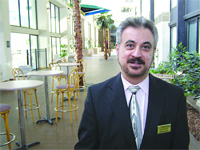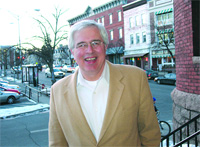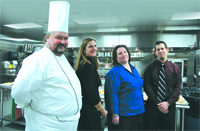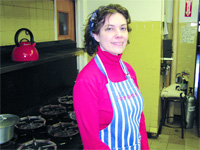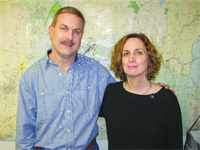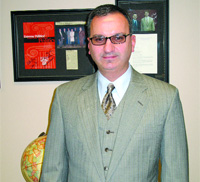Management of nonprofit organizations has always been challenging, but recent legislative, societal, and technological changes have made it even more so. In response, new college degree programs have been created to address a recognized leadership vacuum — resulting from the retirement of many current managers — and make tomorrow’s nonprofit managers better prepared for the hurdles they will face.
Melissa Morris-Olson, founder of the Axelson Center for Nonprofit Management in Chicago and newly appointed director of the Nonprofit Management and Philanthropy program at Bay Path College, puts it succinctly as she describes life for nonprofit organizations today.
“It’s not enough to do good,” she says. “You must do good well.”
That’s a reality being felt across the board by nonprofits — a large group in and of itself that includes businesses focused on health care, human services, education, advocacy, the arts, community development, and many other areas. They’re facing a wide array of challenges, including what Morris-Olson described as a “leadership vacuum” resulting from the retirement of many long-time directors, staff recruitment and retention, and the intricacies of fundraising.
At the same time, however, nonprofits are also seeing a new set of advantages, including the enormous power of the Internet to market themselves, raise funds, and recruit managers and volunteers, which is causing a marked shift in how they do business.
These trends point to the need for better training of nonprofit managers, and colleges such as Bay Path are responding with new degree programs aimed at putting more leaders in the pipeline, and giving them the skills they’ll need to succeed in a more challenging environment.
“There was a time when nonprofits saw themselves on a different level than for-profits, in part because of the good work they do,” said Morris-Olson. “It’s true that they have played an incredibly important role in our history, serving almost as a safety valve during troubled times. Without them, I can’t imagine how some major historic events — from natural disasters to the fight for civil rights — would have played out.
“But leaders need to know how to explain and defend their organizations and their missions,” she continued. “They need to know how to report on their work, spend money responsibly, and overall, to manage well.”
Virtual Channels
Nonprofit leaders cite a number of factors when asked about how their business has changed. Some are similar to shifts in business practices that all sectors are seeing, such as technological upgrades and the need to be increasingly competitive to recruit and retain staff. But others are more difficult to pinpoint, including a growing interest in working with nonprofits among various age groups, either as staff or as at the volunteer level.
Michelle Theroux, executive director of Child and Family Services of the Pioneer Valley, said staff recruitment and retention are two areas in which nonprofits have historically struggled, and they remain a constant concern.
“It’s a huge economic challenge to be a player,” she said. “We do good work, so there is an attachment to mission-driven practices, but that doesn’t mean we don’t have to make ourselves marketable to keep staff here. We want to offer competitive benefits to our staff, but there is a delicate balance between what we want to offer and what we can afford.”
Similarly, Herb Heller, Food Processing Center Manager of the Franklin County Community Development Corp. (FCCDC), said he sees firsthand the challenges that nonprofit companies face, in contrast with for-profit businesses. The FCCDC is a unique nonprofit organization that works in part to assist fledgling for-profit businesses, including those in the food and beverage industry through the processing center. He said nonprofits in general have different cultures and structures than for-profits due to the work they do, which can make management more difficult.
“Some challenges never change for nonprofits — sometimes, the biggest challenge is still keeping the lights on,” said Heller, who added, however, that along with constant hurdles, nonprofits also possess a number of positives that are now being recognized as intrinsic to the overall economy and climate of commerce.
“Nonprofits are very good at getting to the heart of the matter,” he said. “Because of that, we are able to garner support effectively, and with community support and good management, nonprofits are a type of business that can survive the tough times, and even help the for-profits through those times.”
And increasingly, Heller said, that realization is leading to some new, innovative practices within the nonprofit sector, and a renewed interest in the work they do among job seekers, potential volunteers, and would-be contributors.
“We’re seeing a widening of interest in nonprofits,” he said. “People understand that they can find new business opportunities through their involvement, and that is creating a pipeline to our doors.”
The reasons for this phenomenon vary, but all of them track back to a new sense of interest in the nonprofit sector. Bruce Marshall, senior vice president for development with the American Cancer Society’s Northeast affiliate, said one contributing factor could be the ease with which information can be attained in today’s highly connected world.
“The short answer as to why is the Internet,” said Marshall. “It has changed the way nonprofits and for-profits do business in similar ways, but on our end it’s exciting to see the variety of improvements.”
For instance, Marshall said last year the ACS raised more than $6 million through virtual channels — contributions made through Web sites and online solicitations. And in 2006, one of its more mature programs, Making Strides Against Breast Cancer, saw a 20% increase in revenue over the previous year; historically, older programs tend to bring in smaller numbers.
“Six years ago, we wouldn’t have been anywhere near that number,” he said. “And you can see the evolution … once, people reached for their checkbook and stamps. Now, they reach for their credit cards and look for a Web site address.”
Internet marketing and the ability to make online contributions has also helped many nonprofits expand their donor base, especially among younger generations, he said.
“Older people still give more, but we’re complementing existing numbers more and more with younger donors,” said Marshall. “I think part of the reason why is because through the Web, we are able to communicate more efficiently how every dollar is used. Younger people also like to get involved on a level at which they’re comfortable, and the Internet is probably the most effective way to engage them.”
The Gift of Time
There are other, societal trends that are also shaping the future of nonprofits and their fundraising efforts; as the population ages, for instance, Marshall said giving trends are starting to change.
“In terms of involvement with nonprofit and charitable groups, younger people already show a propensity toward being more hands-on,” Marshall added. “They like to get involved and take on specific projects. The older generations have historically been more likely to give unrestricted gifts, but as the number of younger people getting involved rises, so does interest in restricted projects.”
That trend is also leading to greater numbers of volunteers within nonprofits partly in lieu of solely financial contributors, but Marshall said he doesn’t see that as harmful to the bottom line. He said the more connected to a group an individual feels, the more likely it is that he or she will continue to support that organization for a long period of time, through both financial and in-kind contributions.
“Engaging donors as advocates increases retention rates,” he said, “and I’m a firm believer that, in general, involvement yields investment.”
Theroux agreed. She said Child and Family Services relies greatly on third-party reimbursements and contracts with state and federal agencies such as the Department of Social Services, but its fund-development program is still robust, and is made up largely of contributors who feel a sort of kinship with the organization.
“It could be a grateful client or a supporter of our cause, and it spans all age groups,” she said, noting that Child and Family Services will soon embark on a new series of fundraising appeals and events designed around that trend. “The main theme will be a connection back to the agency,” she said.
Marshall added that campaigns planned around such national trends are proof that the very face of these organizations is starting to change. They still need to become savvier in terms of marketing, fundraising, and translating missions and goals to a larger audience, he said, to make them a more attractive option to job seekers than in the past.
But Marshall, who started his career with the ACS 20 years ago, said one of the biggest changes to the nonprofit landscape is the availability of educational programs to teach those very skills.
“When I started, interest in working with nonprofits was relegated to a small group of people, and in turn it was rare to see any courses at the college level devoted to nonprofit management,” he said. “People who work with a nonprofit organization need some specific skills, such as knowledge of nonprofit sales, communication, marketing, and the ability to focus on net dollars. And today, I do see colleges addressing those areas.”
A Collegiate Contribution
Schools are doing so not only with random courses and informational programs, but with new degree offerings in Nonprofit Management and Philanthropy. They are designed to help fill the need for qualified personnel within such organizations, a problem that is becoming acute as many long-term administrators retire.
According to a study completed by Seton Hall University in the late 1990s and updated in 2002, there are about 255 colleges and universities in the U.S. offering some kind of nonprofit management curricula. Of those, 114 offer a graduate degree with at least a concentration in that field.
Locally, two colleges have recently entered the nonprofit management arena with graduate-degree programs; a master of science in Nonprofit Management at American International College in Springfield and a master of science in Nonprofit Management and Philanthropy at Bay Path College in Longmeadow.
Roland Holstead, vice president for Educational Enterprise and dean of Graduate and Continuing Education at American International College, said the private, four-year institution’s foray into nonprofit management was a response to recognized needs at a number of such organizations in the region.
“Many people expressed the belief that there was a need to develop particular skills to augment the work being done in the nonprofit sector, particularly at the mid-career level,” he said.
AIC announced its master’s degree program in Nonprofit Management last November. Holstead explained that it’s an interdisciplinary program that draws from many different courses and majors at the college, such as Public Administration, Organization Development, Business Studies, and Psychology, in response to the specific skill sets required by most nonprofit businesses, among them grant-writing, fundraising, human resources management, and a knowledge of nonprofit law.
“We believe that to help nonprofits become more efficient and effective, new skills are essential in addition to the compassion that many employees of nonprofits already possess,” he said, noting that changes in the economic climate and on the legislative level consistently create a fragile environment within the nonprofit sector, and many of AIC’s courses will focus on that reality.
“In terms of nonprofit law, for instance, there are new restrictions emerging now that nonprofits need to be very aware of,” he said. “And in terms of recruiting and retaining personnel, there are several things that people need to know. Nonprofits have to look differently at full-time, part-time, flex-time, and per-diem employees than for-profit businesses to meet the needs of their clients, and of their employees. Hours might be very different, and schedules more unconventional.”
Currently, the AIC master’s program, which will be marketed more aggressively for the fall 2007 semester, has 10 students and a capacity of about 60. All of the master’s candidates are already employed by nonprofit organizations, which Holstead said run a wide gamut, including hospitals, human service, and relief organizations like the American Red Cross.
Similarly, Morris-Olson said Bay Path recognized a need for nonprofit management preparation at the ground level, and created its program in response to both national and regional trends.
The program’s first class is enrolled now, and as part of their coursework, the students will be paired with local nonprofit organizations — about 35 of them — to help solve specific problems within those businesses. Morris-Olson said the fact that not one organization she has approached to partner with her students has turned her down speaks to the need for qualified answers to complex issues.
“We see firsthand the need for management training and education for the nonprofit sector,” she said. “One reason why is the leadership vacuum we’re seeing across the country. So many nonprofit leaders are retiring, and in addition, there is an issue of high turnover within nonprofits, among people who joined an organization only to find that they were not adequately prepared.”
In addition, Morris-Olson said that, due to legislative changes and other pressures, nonprofit organizations are also experiencing change at a very fast rate, which in turn underscores the need for formal preparation at the management level.
“Many nonprofit leaders worked their way up without any type of management degree,” she said. “But it’s almost imperative now … the pace of change has really accelerated for nonprofits of late. And this is not old knowledge. In most cases, this is new, cutting-edge knowledge that current nonprofit leaders need, and often worry about.”
Mission vs. Management
Morris-Olson said some of the core themes that are hot topics within nonprofit management include financial management, fundraising, and governance of boards or trustees. She added that successful preparatory programs generally approach these themes with a strong emphasis on the nonprofit perspective and how it differs from governmental and for-profit bodies. Issues surrounding accountability, prompted in part by scandal or disorganization brought to light following major disasters such as 9/11 or Hurricane Katrina, also top the list.
“During those times, some high-profile nonprofit leaders were just skewered in the press,” she said, adding that the philanthropic mission of today’s nonprofits must be coupled with solid business acumen.
Theroux agrees. From her central office in Springfield, she wades through a seemingly never-ending pool of challenges — changes to contracts, complicated funding streams, and health care benefit concerns in light of the Commonwealth’s new system among them. But she said the increased emphasis on education and technology across the nonprofit sector has indeed created a renewed sense of optimism in her field, one that sees the future as promising, not as a series of unknowns.
“We’re still in a period of transition,” she cautioned. “Things are certainly tight, but there are gains to be made, and I think many nonprofit organizations are hopeful about that.
“We’ve been here for 130 years, so we’re not going anywhere,” she said. “But in the future, we will look very different.”
Jaclyn Stevenson can be reached at[email protected]






